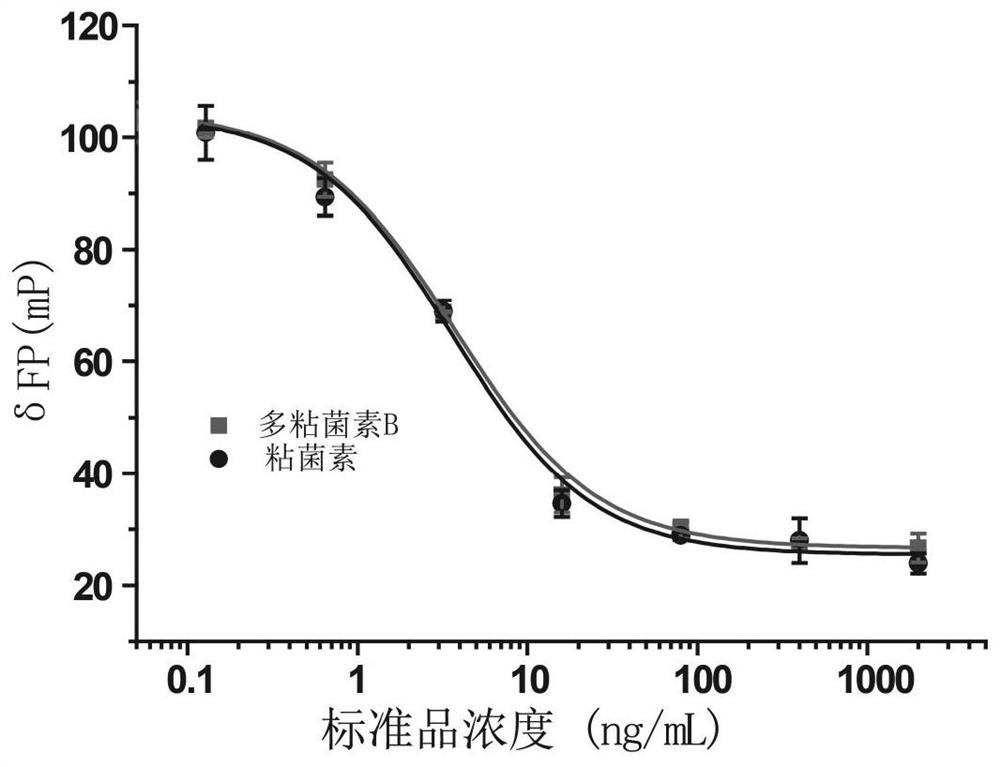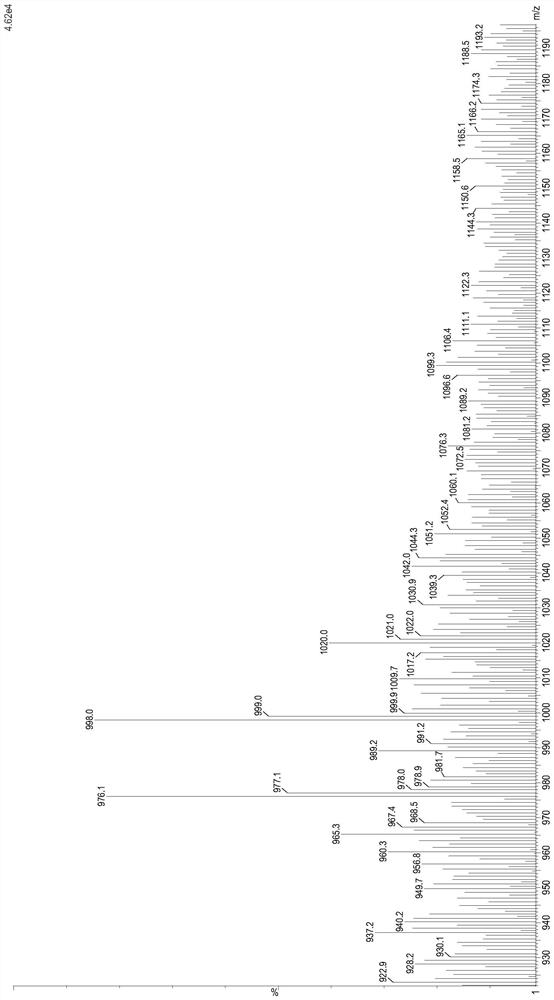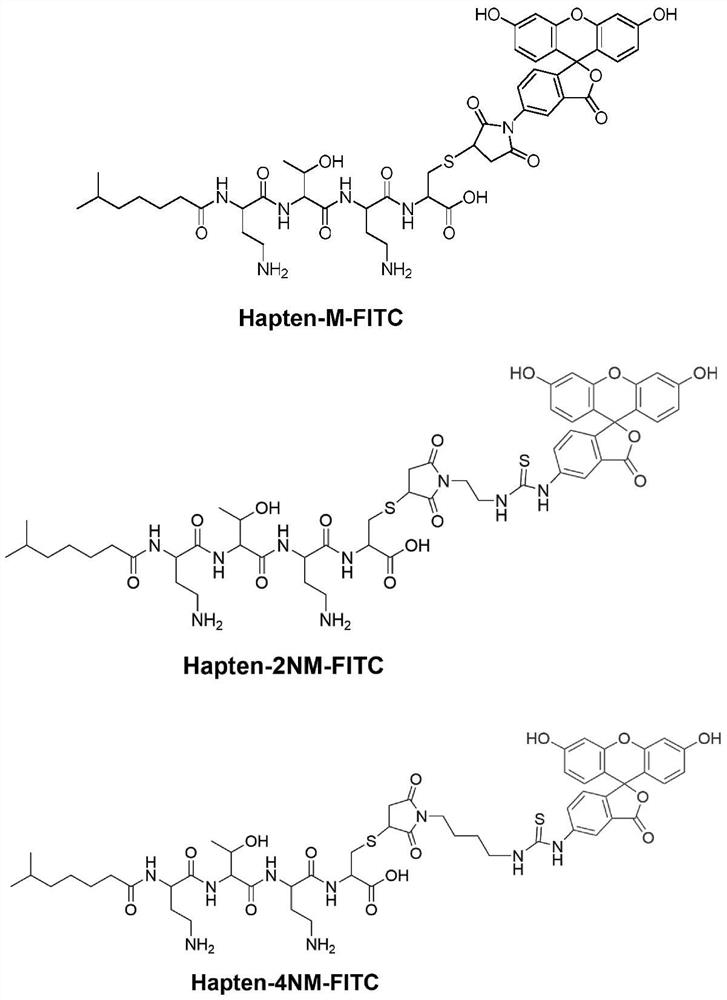Fluorescence polarization immunoassay method for detecting polymyxin
A polymyxin and fluorescence polarization technology, applied in the direction of material analysis by optical means, analyzing materials, fluorescence/phosphorescence, etc., can solve the limitation of effective supervision of polymyxin B and colistin, high operator requirements, Problems such as long detection time, to achieve the effect of satisfying the monitoring of polymyxin blood concentration
- Summary
- Abstract
- Description
- Claims
- Application Information
AI Technical Summary
Problems solved by technology
Method used
Image
Examples
Embodiment 1
[0058] Preparation of embodiment 1 fluorescent marker
[0059] 1. Preparation of fluorescent marker Hapten-M-FITC
[0060] Weigh 2mg of Hapten and 1.56mg of 5-maleimide fluorescein powder, add to 400μL of DMF and shake until dissolved; add 50uL of triethylamine, and react in the dark for 3 hours at room temperature; take 50uL of the reaction solution and use thin layer chromatography ( Separation by TLC, the developing solvent is methanol; the yellow band with R=0.2 is scraped off the silica gel plate, eluted with methanol:water (v:v, 1:1), and detected for later use.
[0061] Mass Spectrometry Identification: The chemical formula of the fluorescent marker Hapten-M-FITC is: C 47 h 57 N 7 o 14 S, the theoretical molecular weight is 976.07. The measured value of mass spectrum: 976.1, consistent with the molecular weight of the target product, see the mass spectrometry results figure 2 .
[0062] 2. Preparation of fluorescent markers Hapten-2NM-FITC, Hapten-4NM-FITC, Hapt...
Embodiment 2
[0073] Example 2 Screening of the best fluorescent marker and antibody combination
[0074] 1. Combine the 12 synthetic fluorescent markers with polymyxin monoclonal antibodies (5D10, 11D5, 14G6 and 17D11) and polymyxin polyclonal antibody pAb respectively. Set to the concentration (10nM) of the corresponding fluorescent marker when the fluorescence intensity is 10 times the background fluorescence intensity of the buffer solution, each antibody is used in borate buffer according to 1 / 100, 1 / 200, 1 / 400, 1 / 800 , 1 / 1600, 1 / 3200, l / 6400, 1 / 12800, 1 / 25600 and 1 / 51200 dilutions, draw the antibody binding curve, and obtain the maximum change value of signal intensity δmP (δmP=mP max -mP min ). For each combination, the antibody dilution concentration with a δmP of 80-120 was selected as the working concentration of the antibody.
[0075] Among them, the polymyxin monoclonal antibody is obtained through cell fusion and hybridoma preparation methods.
[0076] Polymyxin polyclonal ...
Embodiment 3
[0082] The establishment of embodiment 3 FPIA method
[0083] 1. Competing for FPIA
[0084] Use borate buffer (50mmol / L, pH8.0) to configure different concentration gradients of 2000ng / mL, 400ng / mL, 80ng / mL, 16ng / mL, 3.2ng / mL, 0.64ng / mL and 0.128ng / mL polymyxin standard solution. Add 70uL polymyxin standard substance, 70uL fluorescent marker with a working concentration of 10nM and 70uL polymyxin polyclonal antibody solution with a working concentration of 8μg / mL in a 96 black low-binding microwell plate, and incubate at room temperature in the dark After 5 min, the fluorescence polarization value was measured.
[0085] 2. Draw a standard curve
[0086] After the competition reaction, the measured fluorescence polarization value of each well was plotted on the ordinate, and the concentration of the polymyxin standard solution was plotted on the abscissa, and the four-parameter model of Origin 8.0 was used to fit the standard curve.
[0087] Fluorescence polarization stand...
PUM
 Login to View More
Login to View More Abstract
Description
Claims
Application Information
 Login to View More
Login to View More - R&D
- Intellectual Property
- Life Sciences
- Materials
- Tech Scout
- Unparalleled Data Quality
- Higher Quality Content
- 60% Fewer Hallucinations
Browse by: Latest US Patents, China's latest patents, Technical Efficacy Thesaurus, Application Domain, Technology Topic, Popular Technical Reports.
© 2025 PatSnap. All rights reserved.Legal|Privacy policy|Modern Slavery Act Transparency Statement|Sitemap|About US| Contact US: help@patsnap.com



